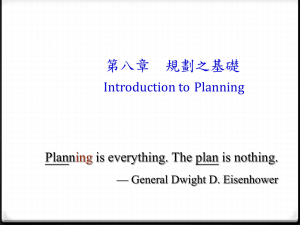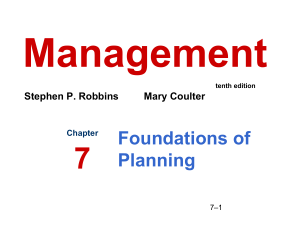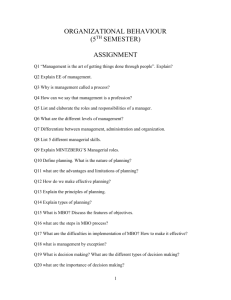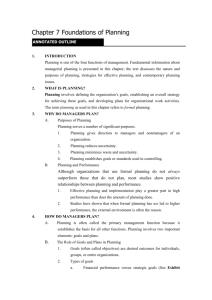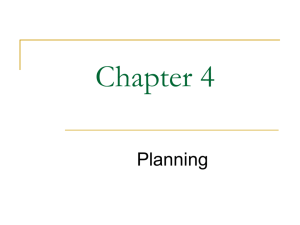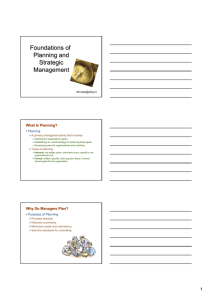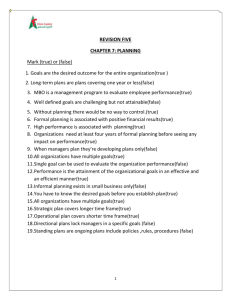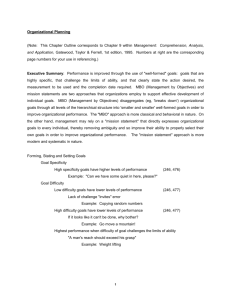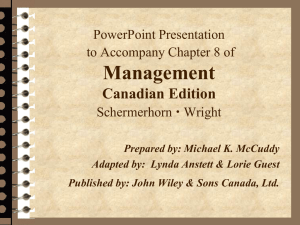Chapter One Managers and Management
advertisement
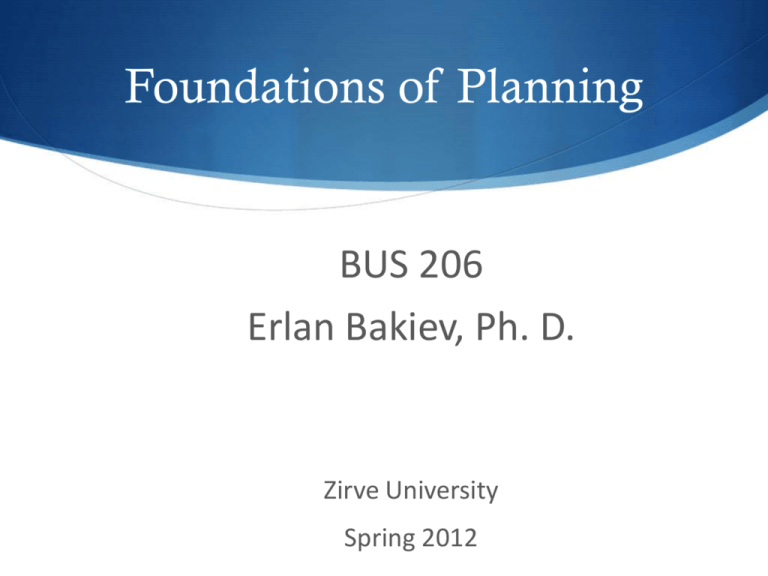
Foundations of Planning BUS 206 Erlan Bakiev, Ph. D. Zirve University Spring 2012 Define the nature and purpose of planning Classify the types of goals organizations might have and the plans they use Compare and contrast approaches to goal-setting and planning Discuss contemporary issues in planning What Is Planning? Planning - a primary managerial activity that involves: Defining the organization’s goals Establishing an overall strategy for achieving those goals Developing plans for organizational work activities Formal Planning Formal planning Specific goals covering a specific time period Written and shared with organizational members Why Do Managers Plan? Purposes of Planning Provides direction Reduces uncertainty Minimizes waste and redundancy Sets the standards for controlling Planning and Performance Formal planning is associated with: Higher profits and returns on assets Positive financial results The quality of planning and implementation affects performance more than the extent of planning The external environment can reduce the impact of planning on performance Elements of Planning Goals (also Objectives) Desired outcomes for individuals, groups, or entire organizations Provide direction and evaluation performance criteria Plans Documents that outline how goals are to be accomplished Describe how resources are to be allocated and establish activity schedules Types of Goals Financial Goals - related to the expected internal financial performance of the organization. Strategic Goals - related to the performance of the firm relative to factors in its external environment (e.g., competitors). Types of Plans Strategic Plans Establish the organization’s overall goals Seek to position the organization in terms of its environment Cover extended periods of time Operational Plans Specify the details of how the overall goals are to be achieved Cover a short time period Types of Plans Long-Term Plans Time frames extending beyond three years. Short-Term Plans Time frames of one year or less. Types of Plans Specific Plans Plans that are clearly defined and leave no room for interpretation. Directional Plans Flexible plans that set out general guidelines and provide focus, yet allow discretion in implementation. Types of Plans Single-Use Plan A one-time plan specifically designed to meet the need of a unique situation. Standing Plans Ongoing plans that provide guidance for activities performed repeatedly. Traditional Goal Setting Broad goals are set at the top of the organization. Goals are then broken into sub-goals for each organizational level. Goals are intended to direct, guide, and constrain from above. Goals lose clarity and focus as lower-level managers attempt to interpret and define the goals for their areas of responsibility. Exhibit 8-2: The Downside of Traditional Goal Setting Maintaining the Hierarchy of Goals Means-Ends Chain The integrated network of goals that results from establishing a clearly-defined hierarchy of organizational goals. Achievement of lower-level goals is the means by which to reach higher-level goals (ends). Management By Objectives (MBO) Specific performance goals are jointly determined by employees and managers. Progress toward accomplishing goals is periodically reviewed. Rewards are allocated on the basis of progress towards the goals. Management By Objectives (MBO) Key elements of MBO: goal specificity participative decision making an explicit performance/evaluation period feedback Exhibit 8-3: Steps in a Typical MBO Program Does MBO Work? Reason for MBO Success Top management commitment and involvement Potential Problems with MBO Programs Are less effective in dynamic environments that require constant resetting of goals Overemphasis on individual accomplishment may create problems with teamwork Allowing the MBO program to become an annual paperwork shuffle Exhibit 8-4: Well-Written Goals Steps in Goal Setting 1. Review the organization’s mission statement. Do goals reflect the mission? 2. Evaluate available resources. Are resources sufficient to accomplish the mission? 3. Determine goals individually or with others. Are goals specific, measurable, and timely? Steps in Goal Setting 4. Write down the goals and communicate them. Is everybody on the same page? 5. Review results and whether goals are being met. What changes are needed in mission, resources, or goals? Contingency Factors in Planning Manager’s level in the organization Strategic plans at higher levels Operational plans at lower levels Degree of environmental uncertainty Stable environment: specific plans Dynamic environment: specific but flexible plans Contingency Factors in Planning Length of future commitments Commitment Concept: Current plans affecting future commitments must be sufficiently long-term in order to meet those commitments. Exhibit 8-5: Planning in the Hierarchy Organizations Approaches to Planning Establishing a formal planning department Create a group of planning specialists that help managers write organizational plans. Planning is a function of management; it should never become the sole responsibility of planners. Approaches to Planning Involving organizational members in the process Plans are developed by members of organizational units at various levels and then coordinated with other units across the organization. Criticisms of Planning Planning may create rigidity. Plans cannot be developed for dynamic environments. Formal plans cannot replace intuition and creativity. Criticisms of Planning Planning focuses managers’ attention on today’s competition—not tomorrow’s survival. Formal planning reinforces today’s success, which may lead to tomorrow’s failure. Planning isn’t enough. Planning in Dynamic Environments Develop plans that are specific but flexible. Understand that planning is an ongoing process. Change plans when conditions warrant alterations. Planning in Dynamic Environments Persistence in planning eventually pays off. Flatten the organizational hierarchy to foster the development of planning skills at all organizational levels. Terms to Know planning directional plans goals single-use plan plans standing plans stated goals traditional goal setting real goals framing strategic plans operational plans long-term plans short-term plans specific plans means-ends chain management by objectives (MBO) mission commitment concept formal planning department
